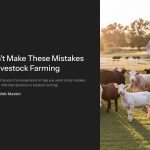 Embarking on the journey of establishing a small-scale livestock farm is both exciting and challenging. To ensure your venture thrives, it’s crucial to approach it with careful planning and informed decision-making. This guide provides comprehensive insights and actionable steps to help you navigate the path to a successful livestock farming business.
Embarking on the journey of establishing a small-scale livestock farm is both exciting and challenging. To ensure your venture thrives, it’s crucial to approach it with careful planning and informed decision-making. This guide provides comprehensive insights and actionable steps to help you navigate the path to a successful livestock farming business.

Understanding the Livestock Industry Landscape
Before diving into livestock farming, gaining a thorough understanding of the industry is paramount. This involves researching current market trends, consumer demands, and potential challenges within the livestock sector. Familiarize yourself with different types of livestock farming—such as cattle, poultry, or swine—and assess which aligns best with your resources, interests, and market opportunities.

Developing a Robust Business Plan
A well-structured business plan serves as the foundation of your farming enterprise. It should encompass:
- Mission and Vision Statements: Define the purpose and long-term goals of your farm.
- Market Analysis: Identify your target market, analyze competitors, and determine demand for your products.
- Operational Plan: Outline the logistics of farm operations, including location, facilities, equipment, and staffing.
- Financial Projections: Estimate startup costs, operational expenses, revenue streams, and profitability timelines.
- Risk Management Strategies: Anticipate potential risks and devise contingency plans to mitigate them.
Crafting a detailed business plan not only guides your operations but also proves essential when seeking financing or partnerships.

Securing Appropriate Funding and Resources
Starting a livestock farm requires significant investment in land, infrastructure, livestock, feed, and other essentials. Explore various funding options such as personal savings, loans, grants, or government assistance programs tailored for agricultural startups. For instance, the 2025 Young Farmer Support Project offers financial aid and resources to aspiring farmers. Ensure you have a clear understanding of the terms and obligations associated with any financial assistance you pursue.

Acquiring Essential Knowledge and Skills
Success in livestock farming hinges on possessing the necessary knowledge and skills. Engage in educational programs, workshops, and training sessions focused on animal husbandry, farm management, and sustainable agricultural practices. Institutions and agricultural extension services often provide valuable resources and support for new farmers. Additionally, consider seeking mentorship from experienced farmers to gain practical insights and guidance.

Navigating Legal and Regulatory Requirements
Compliance with legal and regulatory standards is critical in livestock farming. This includes:
- Zoning Laws: Ensure your chosen farm location adheres to local zoning regulations for agricultural activities.
- Environmental Regulations: Implement waste management and environmental protection measures as mandated by law.
- Animal Welfare Standards: Maintain humane and ethical treatment of animals in line with established guidelines.
- Health and Safety Codes: Adhere to protocols that safeguard the health of both livestock and farm workers.
Familiarize yourself with the specific regulations in your region and secure any necessary permits or licenses before commencing operations.

Implementing Effective Marketing and Sales Strategies
To achieve profitability, develop robust marketing and sales strategies that connect your products with consumers. Consider the following approaches:
- Brand Development: Create a strong brand identity that reflects the quality and values of your farm.
- Direct-to-Consumer Sales: Explore avenues such as farmers’ markets, farm stands, or online platforms to sell products directly to consumers.
- Wholesale Partnerships: Establish relationships with local retailers, restaurants, or distributors to expand your market reach.
- Value-Added Products: Diversify your offerings by processing raw products into items like cheese, yogurt, or cured meats, which can command higher prices.
Utilizing a mix of these strategies can enhance your market presence and drive sales.
Conclusion
Launching a small-scale livestock farm demands meticulous planning, continuous learning, and strategic execution. By thoroughly understanding the industry, crafting a solid business plan, securing necessary resources, acquiring relevant skills, adhering to legal requirements, and implementing effective marketing strategies, you position your farm for sustainable success. Embrace the journey with dedication and resilience, and your livestock fa
*Capturing unauthorized images is prohibited*



